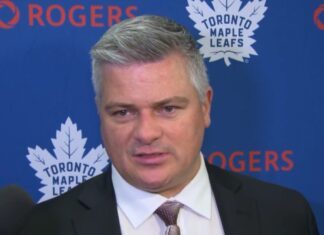 Maple Leafs‘ GM Brian Burke, per the Toronto Star:
Maple Leafs‘ GM Brian Burke, per the Toronto Star:
“We intend to be pushing the cap every year. We want to spend the money intelligently. We’re Big Blue, we’re going to spend to the cap.”
Now, your initial reaction to that is probably one of surprise, given Burke’s previous statements about a potential cap decline. Does that mean his statement today runs counter to the theory of a rebuilding effort? Not at all.
Before anybody gets too wound up over this quote and begins to recall the ghosts of Leafs‘ GMs past, let’s take a look at the numbers.
2010-11 is the season that is on everybody’s radar, with the cap expected to drop by an amount somewhere in the $5 million range. Will a spending spree by Burke & Co put the Leafs in danger of being in a situation where they are over the cap, if it declines? Not if the signings are managed properly.
Currently, the Leafs have only five NHL regulars committed to for the 2010-11 season, for a total of $15.6 million (Blake, Finger, Hagman, Kaberle and Schenn … this figure also includes $1m on the books for Tucker’s buyout). Beyond those five players, only nine more in the system are signed to Standard Player Contracts (Berry, Bozak, Didomenico, Giliati, Hanson, Mitchell, Reimer, Scott, Stalberg).
In other words, cap space is anything but a problem.
If Burke spends up to the cap limit in 2009-10, he will be able to offset any potential damage of a cap decrease by trading, or opting not to re-sign, players whose contracts are set to expire following the 2009-10 season. Notable players who are slated to be UFAs next off-season include Frogren (1m), Kubina (5m), Mayers (1.3m), Ponikarovsky (2.1m), Stempniak (2.5m), Van Ryn (2.9m), and Toskala (4m).
That’s $18.8 million potentially freeing up, following next season. Even if the cap does decline by $5 million, that still leaves Burke $13.8 million to work with for the 2010-11 season, if he spends to the 2009-10 cap limit.
Suddenly, Burke’s willingness to spend to the cap is beginning to make a lot of sense.
And seriously, the desire to spend should not come as a big surprise. I’ve said this before, and I will say it again: there is no way MLSE will let their team miss the playoffs for a fifth straight year. Burke and Wilson were brought in to make the Leafs a playoff team again, and 2008-09 was their season of grace. But the pressure to return to the playoffs is now on. Can Burke use the FA market to build a team that can not only make the playoffs, but also a contender for many years to come? Certainly, so long as he avoids the decade-long contracts.
The key for success, for any team in a salary-capped league, is not the desire to spend so much as the ability to structure the expenditures properly. In other words, so long as Burke is able to manage the contracts so that a certain amount of money is freed up in the form of expiring contracts each off-season, the Leafs should be able to incorporate the free agent market into their rebuilding efforts with ease.
Remember, UFAs are now much younger than before, due to the terms of the collective bargaining agreement. Remember also that with today’s conditioning levels and equipment, skill players are playing at a high level well into their late-30s. You can find good players in their mid-20s who have yet to hit their prime, who want to test the market. A 26-year-old signee still has close to a decade’s worth of good hockey ahead of him, including his best years. That can only help a rebuilding effort, and it is players in that age category that Burke was thinking of when making the statements that he did.
The most important part of a rebuilding effort, however, is balance. The draft is important, but the fact remains it is also a crapshoot, and cannot be relied upon as the sole mechanism by which to build a team. An effective rebuilding program will put an emphasis on the draft, but will also target players in the FA market who are young enough to be effective for the team for several years and will be in their prime playing years (27 – 32) when the team is ready to compete. Achieving a balance between good drafting, young FA signings, and intelligent cap management is the best path to success in the new NHL.
And that is exactly what Brian Burke is trying to do. He talked about the value of NCAA players, then went out and signed a couple. He talked about the importance of the draft, and has been making efforts to move up in the order. And now, he is talking about the free agent market, which is as young this off-season as it has ever been. Don’t doubt that he will back up his words once more.
And when you look at the numbers, and the contracts set to expire, Burke’s desire to shop the FA market begins to make a lot more sense for both now and the future.
































